Putting your child's desk in the living room can improve their grades! Is your study room designed correctly?
As living standards improve, many families now tend to set up desks in independent children's rooms for their children to study. However, in recent years, the method of setting up children's study space in public areas such as the living room has also attracted a lot of attention.
The reason is: "Until elementary school graduation, studying and reading in the living room is more efficient than doing homework in the child's own room, because when a child is alone in the room, he often starts playing games unconsciously" and "Children will pay attention to their parents' expressions, so they can concentrate better."
In an environment where they can be "monitored" by their parents to a certain extent, children can feel more secure and be better able to concentrate. Similarly, this learning atmosphere will also affect the activities of parents, invisibly enhancing the willingness of the whole family to learn and read.
Simply put, children get better grades when doing homework in the living room.
Some parents may ask, where is the place in the living room for children to do homework? In fact, there are many ways to set up a child's desk in public activity areas such as the living room, such as making a desk on one side of the dining table, so that the mother can communicate with the child while cooking↓↓↓
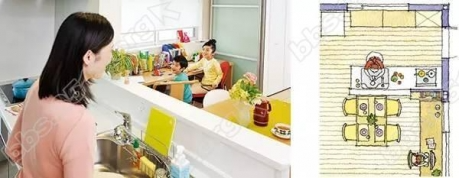
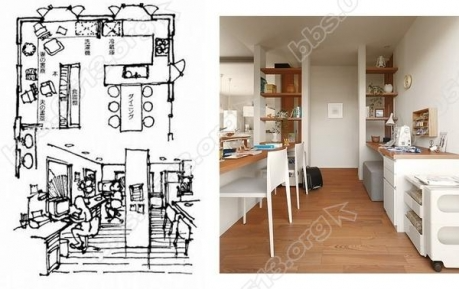 Facts have proved that children learn in family life. In addition to the words and deeds of their parents, the subtle influence of the living space should not be underestimated .
Facts have proved that children learn in family life. In addition to the words and deeds of their parents, the subtle influence of the living space should not be underestimated .
Design to help children develop good habits
1. Storage habits
Many families pay great attention to the cultivation of children's storage habits. Used toys, clothes after returning home, their own books, etc., will be stored as soon as possible after use by children to avoid accumulation. To this end, creating a space that is convenient for children to store is the key.
In order to let small children also experience the fun of storage and organization, it is advisable to set up some storage spaces near the children's activity area that children can easily reach.
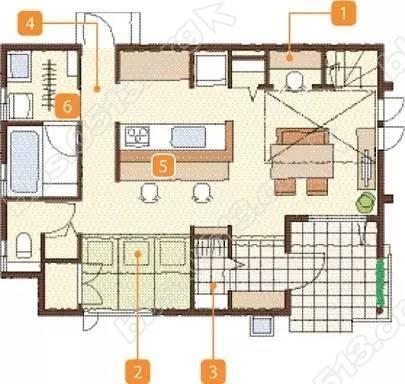 For example, setting up storage cabinets or bookshelves near the child’s activity space allows the child to put away used items at any time, while also cultivating the child’s interest in reading.
For example, setting up storage cabinets or bookshelves near the child’s activity space allows the child to put away used items at any time, while also cultivating the child’s interest in reading.

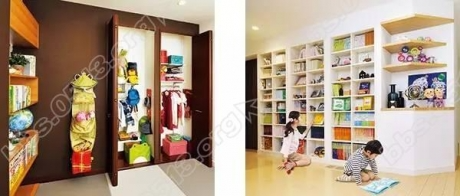 2. Clean habits
2. Clean habits
Washing hands before entering the house after returning from outside is an important lifestyle to prevent diseases, but it is troublesome to go to the bathroom. As shown in the figure below, setting a washbasin on the route into the room will naturally help children develop the habit of washing hands before returning home.
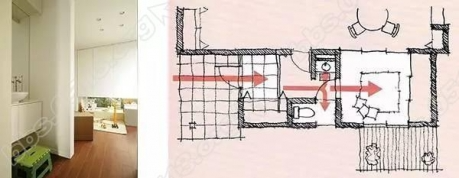 Designs that are more conducive to family communication
Designs that are more conducive to family communication
1. Open kitchen
Although open kitchens have the problem of oil smoke, one of the great benefits is that they can promote communication between family members. If it is an open kitchen, arranging a bar in front of the workbench is the best layout for communicating with family members while cooking.
At the same time, letting children actively participate in housework activities is also a kind of responsibility education, but it is necessary to consider the dangerous factors in advance. Therefore, it is also very effective to set up some shorter storage cabinets opposite the kitchen workbench so that children can help take out their own tableware and put it on the table, help with chopsticks, etc.
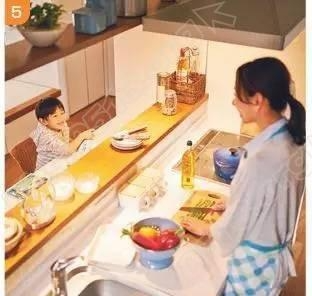 2. Space for interacting with children
2. Space for interacting with children
Considering that children have different levels of dependence on their parents and different ways of activities at different stages, the apartment in the picture below provides a better solution for the three stages of children's growth by changing the layout of furniture↓↓↓
 When the child is an infant, he or she shares a bedroom with his or her parents. The extra space can be arranged as a family activity room, and another room can be used as a walk-in storage room.
When the child is an infant, he or she shares a bedroom with his or her parents. The extra space can be arranged as a family activity room, and another room can be used as a walk-in storage room.
When the child is a little older, he or she tries to have his or her own space, but at the same time needs to keep in close contact with his or her parents. Therefore, the living room is arranged in an adjacent position, and the function of the living room is moved to the original location of the cloakroom. If a second baby is born at this time, the crib in the original parent's bedroom can continue to be used.
When both children grow up, they occupy separate rooms, each with a bed and a desk.
In addition, the game space for interacting with children is mostly arranged in public activity areas such as the living room and dining room. Only a small corner is needed to place the child's toys, or a blackboard, Lego wall, etc. are set up to enrich the content of the common activities.
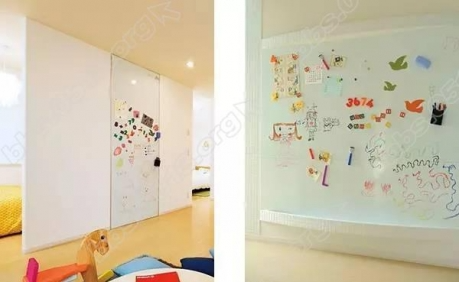 Children begin to need their own space at the age of three. In adolescence, social relationships will affect children's perception of themselves, and they will try to find a new self. During this period, there is a strong desire for personal space, but it is full of risks in terms of mental health.
Children begin to need their own space at the age of three. In adolescence, social relationships will affect children's perception of themselves, and they will try to find a new self. During this period, there is a strong desire for personal space, but it is full of risks in terms of mental health.
Therefore, the effect of a good children's room design on children is most significant in junior high and high school. So, does your home design meet the standards?

Home
Furniture
The reason is: "Until elementary school graduation, studying and reading in the living room is more efficient than doing homework in the child's own room, because when a child is alone in the room, he often starts playing games unconsciously" and "Children will pay attention to their parents' expressions, so they can concentrate better."
Studies have shown that -
In an environment where they can be "monitored" by their parents to a certain extent, children can feel more secure and be better able to concentrate. Similarly, this learning atmosphere will also affect the activities of parents, invisibly enhancing the willingness of the whole family to learn and read.
Simply put, children get better grades when doing homework in the living room.
Some parents may ask, where is the place in the living room for children to do homework? In fact, there are many ways to set up a child's desk in public activity areas such as the living room, such as making a desk on one side of the dining table, so that the mother can communicate with the child while cooking↓↓↓

The desk made in the housework room can also be used to do housework activities with mom at the same time, making it easier to communicate↓↓↓

Design to help children develop good habits
1. Storage habits
Many families pay great attention to the cultivation of children's storage habits. Used toys, clothes after returning home, their own books, etc., will be stored as soon as possible after use by children to avoid accumulation. To this end, creating a space that is convenient for children to store is the key.
In order to let small children also experience the fun of storage and organization, it is advisable to set up some storage spaces near the children's activity area that children can easily reach.



Washing hands before entering the house after returning from outside is an important lifestyle to prevent diseases, but it is troublesome to go to the bathroom. As shown in the figure below, setting a washbasin on the route into the room will naturally help children develop the habit of washing hands before returning home.

1. Open kitchen
Although open kitchens have the problem of oil smoke, one of the great benefits is that they can promote communication between family members. If it is an open kitchen, arranging a bar in front of the workbench is the best layout for communicating with family members while cooking.
At the same time, letting children actively participate in housework activities is also a kind of responsibility education, but it is necessary to consider the dangerous factors in advance. Therefore, it is also very effective to set up some shorter storage cabinets opposite the kitchen workbench so that children can help take out their own tableware and put it on the table, help with chopsticks, etc.

Considering that children have different levels of dependence on their parents and different ways of activities at different stages, the apartment in the picture below provides a better solution for the three stages of children's growth by changing the layout of furniture↓↓↓

When the child is a little older, he or she tries to have his or her own space, but at the same time needs to keep in close contact with his or her parents. Therefore, the living room is arranged in an adjacent position, and the function of the living room is moved to the original location of the cloakroom. If a second baby is born at this time, the crib in the original parent's bedroom can continue to be used.
When both children grow up, they occupy separate rooms, each with a bed and a desk.
In addition, the game space for interacting with children is mostly arranged in public activity areas such as the living room and dining room. Only a small corner is needed to place the child's toys, or a blackboard, Lego wall, etc. are set up to enrich the content of the common activities.

Therefore, the effect of a good children's room design on children is most significant in junior high and high school. So, does your home design meet the standards?
